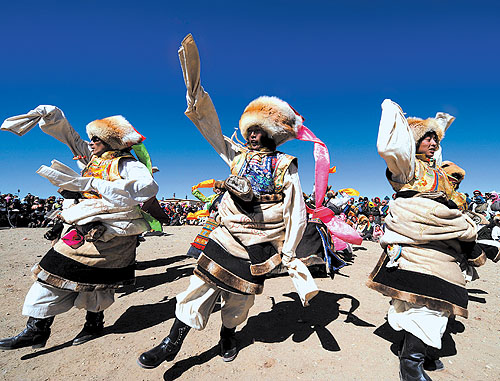|
 Tibetans make up the bulk of the Tibetan opulation in Tibet. Here are dancing herders.
Tibetans make up the bulk of the Tibetan opulation in Tibet. Here are dancing herders.
From the 7th to the 18th century, as a result of natural calamities, diseases and poor medical conditions, plus the fact that monks and nuns were not allowed to marry, the Tibetan population registered negative growth. In the 200 years from the 18th to the mid-20th century, the population further declined by 800,000.
Data shows that the period from 1951 to the present time is the one witnessing the fastest growth of the Tibetan population in the past. Tibet's population birth rate and natural growth rate have all stayed higher than the national average since 1956. According to the 1 percent population sample survey, as of the end of 2007, Tibet's total population reached 2.8415 million. There was a net increase of 1.7006 million as against 1.1409 million in 1951 when the Tibet won the peaceful liberation. The figures also put the fertility rate at 16.4 percent, the death rate 0.51 percent and the natural growth rate 1.13 percent. The life expectancy rose to 67 years old from 35.5 years old. According to statistics released by the Aging Work Committee of TAR, among the 2.8415 million people in Tibet, there are 19,500 aged from 80 to 99, and 79 aged 100 or above, making this period one with the most elder aged 100 or above in Tibetan history and this region one of the provinces and regions with the most elder aged 100 or above around the country.
About 18.9 percent of the Tibetan population lives in urban areas, and 81.1 percent in rural and livestock breeding areas. Tibet sees an uneven distribution of population, with the greatest concentration in the southern and eastern parts; only a small number of people live in the western and northwestern parts.
The Tibet Autonomous Region has the smallest population and is the most sparsely populated among China's provinces, autonomous regions and municipalities directly under the Central Government. The average population density stood at 2.26 people per square km, equaling one-60th of the national average. The Lhasa Plain, the plains at the middle and lower reaches of the Nyangqu River and the Zetang Plain have about 50 residents per square km, and there are more than 100 people per square km in the vicinity of the Chengguan District in Lhasa. The upstream section on the middle reaches of the Yarlung Zangbo River, upper reaches of the Lhasa River and the northeastern part of the Hengduanshan mountainous area in east Tibet have a population density of 3-10 people per square km on average. Of these areas, Lhaze, the Sagya Plain, the Nyang River Valley near Nyingchi and the Lancangjiang River Valley are more densely populated. The eastern Ngari and western Nagqu are the areas with the smalled population density in the world, being only 0.23 person per square km. Changtang in northwestern Nagqu is the "no-man" area.
In the late 1970s, China began to widely implement a family planning and population control policy, advocating one child for one couple, with the aim of curbing the rapid population growth. But in Tibet, the Central Government encouraged the autonomous regional government to adopt special policies in accordance with its own conditions. In 1984, the region's government decided to follow a special birth control policy in the regin, following the "one child for one couple" policy among Han officials and workers working in Tibet and encouraging the Tibetan government workers and urban residents wanting a second child to delay doing so. Currently, those practicing family planning make up 8 percent of Tibet's total population. The family planning work has been carried out on a voluntary basis. Forced abortion in any form is prohibited. Tibetan cadres and workers, as well as farmers and herders, who account for 92 percent of the region's total population, are not subject to family planning policies. But they do receive education in scientific contraception methods, rational arrangements for birth and sound child rearing, so as to protect mothers and infants' health and raise the quality of population. In addition, government health departments offer safe, reliable health service to farmers and herders who voluntarily request assistance in birth control.
(China's Tibet Facts and Figures 2008) |
